Atlas PressureAide Centerflow Hopper
Published: 2025-05-01 - By: CNW400
Last updated on: 2025-04-19
Last updated on: 2025-04-19
visibility: Public - Headline

History
Entering the 1950s, an obstacle facing the railroad industry with the expanding use of large covered hoppers, was the clumping and sticking of granular products during the unloading process with gravity outlet gates. Dry, powdery commodities such as: flour, sugar, cement, plastic, clay, fly ash, starch, and products of the like; could ‘cake up’ and slow down or even halt the unloading procedure. Early attempts had brackets mounted to the sides of hopper cars that attached to a pneumatic vibrating system to shake the materials free. Another effective, yet unorthodox method, was to simply bang the sides of the hopper with a sledgehammer or pipe to loosen the blockage. This abuse of equipment, much to the chagrin of the car owners, lead to the practice of “Do Not Hammer” being stenciled on the sides of covered hoppers.General American Transportation Corporation (GATC) was the first to tackle this issue with the GATC 2600-cubic foot Airlside covered hopper being introduced in 1954. The Airslide conception introduced air pressure to dry bulk materials – modifying its arrangement and making it flow like a liquid through a process called fluidization. During fluidization, a gas is introduced to a fine granular material and removes/displaces friction – converting it from a static state into a fluid state. Air is pumped at a low pressure and flows throughout the powdered product causing it to behave like a liquid and flow outward more smoothly.
American Car & Foundry (ACF) was a true-pioneer in the pressure-differential field with the 100-ton, 3500-cubic foot ‘Flexi-Flo’ covered hopper. Used almost exclusively by the New York Central Railroad for powered cement, 220 total cars were built between 1964 and 1966 (seven were built for the ACF subsidiary Shippers Car Line (SHPX)). Fifteen pounds of air pressure was introduced into the hopper to force out the cement. Many of these cars were repainted over the years as they lasted through the Penn Central and Conrail eras.
In 1979, ACF altered the appearance of the pressure-differential hopper to resemble Center Flow cars and released their 5000-cubic foot PressureAide hopper car. Again with 15 pounds of pressure, the covered hopper featured a distinctive dual pipe arrangement running along the sides of the outlet gates and broader stiffener along the upper sides. The top pipe supplied the air pressure, whilst the lower was used for unloading. Once the hopper reaches its destination, the car is affixed to a stationary air supply. As air flows through the dry, powered lading – the interior air pressure of the hopper pushes the commodity out the discharge pipe, maintaining a continuous flow into a storage bin or truck. No pit or conveyer system is required. PressureAide hoppers can unload 100,000 pounds per hour…increasing efficiency and cost savings.
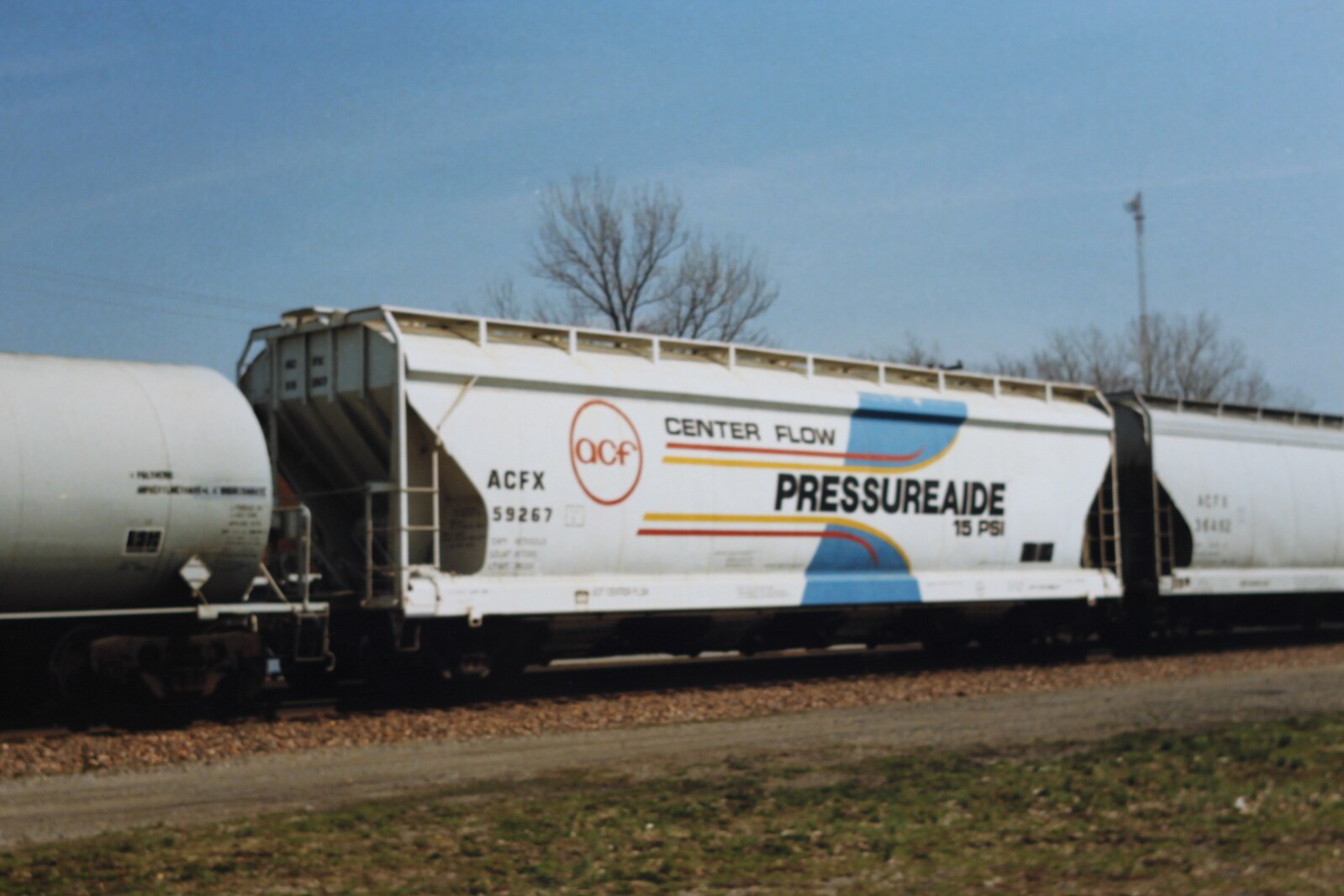
The term Centerflow refers to the central position of the outlet gates in the center of the hopper car – allowing for a quick and even discharge of product. PressureAide indicates the use of air pressure inside a hopper to assist in the outflow of materials. The PressureAide hopper is available with 3, 4, or 5 bays. The bays are labeled in an alpha sequence starting at the ‘B’ end of the car – the ‘B’ end is identified as the point of the car featuring the handbrake.
- Three-hopper car outlets are labeled: B-C-A
- Four-hoppers: B-BC-AC-A
- Five-hoppers: B-BC-C-AC-A
Road Names and Pricing
The most recent collection of Atlas Model Railroad ACF PressureAide Hopper Cars was released in January 2022 with a suggested retail price of $35.95/Undecorated $29.95. The road names included in that series included:- ACFX (Venturi) (White/Blue)
- ADM (Leaf) (Gray/Blue/Green)
- ADM (Molecule) (Gray/Blue)
- Luzenac America (Green/Orange/White)
- Grace Davison (Green/White)
- OMYA (White/Blue)
- Solvay Chemicals (White/Black)
- ACFX (Venturi) Conspicuity Stripes (White/Blue)
- ACFX (Venturi) Orange Sill (White/Blue)
- Undecorated
The subject of my review (Atlas 40052 – Soo Line #101073) was released in October 2000 with a MSRP of $18.95.
The Model
The ready-to-run covered hopper arrived in a clear plastic jewel case with a slip-off cover and a one-piece white plastic cradle to cushion the model. A thin film was wrapped around the model to protect the surface from scuffmarks. The model information was clearly labeled on the end of the case. Found inside the case was a package of Atlas Rapido Style Couplers (#480019), optional for those that desire the older model railroad coupling system.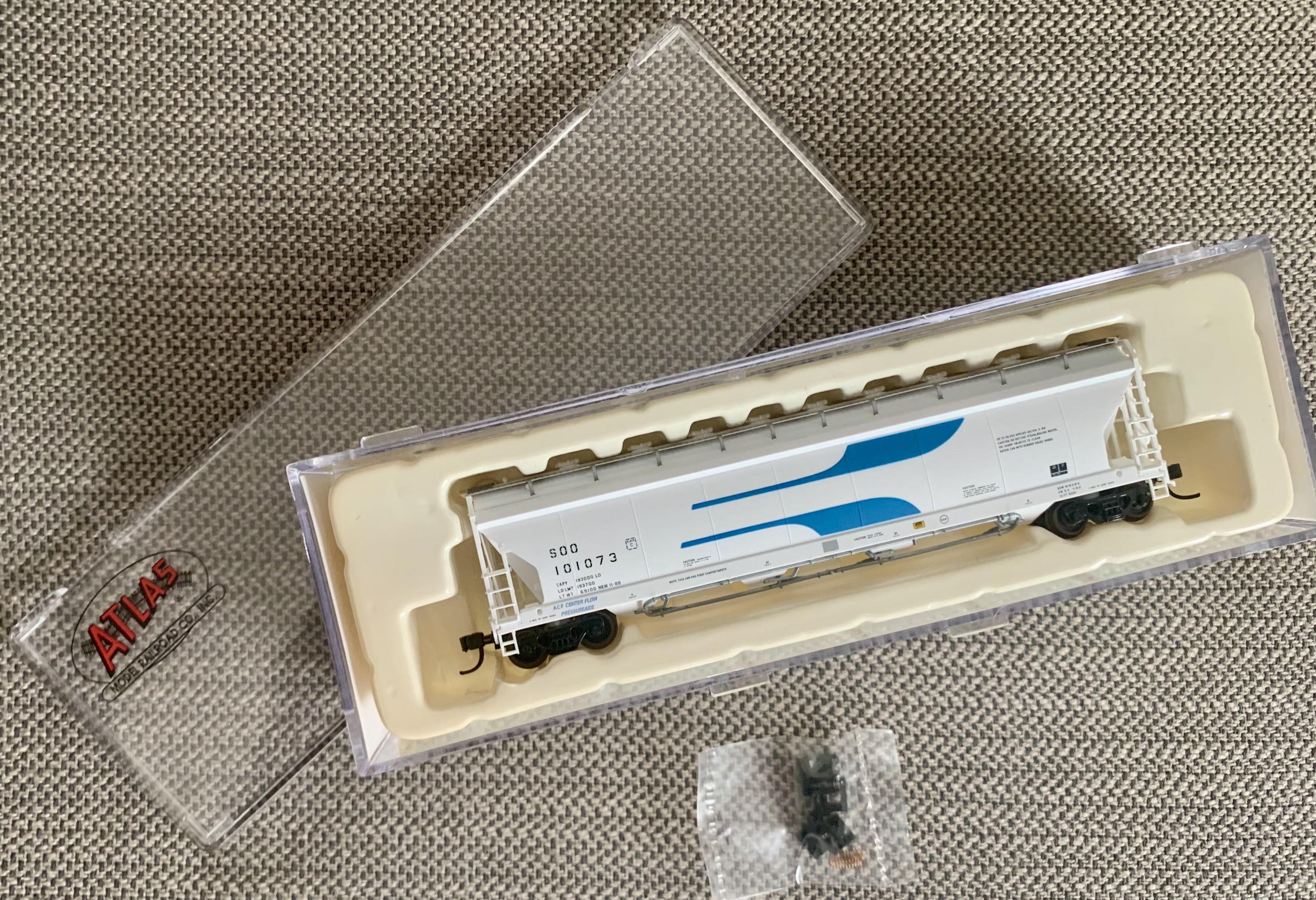
The white and blue colors are crisp and clean along the injection molded plastic hopper. All printing is sharp and fine - even when magnification is needed for minute fonts. The color, placement and size of printing is identical to that found on prototype images. Leased ACF hoppers are effortlessly recognized by the ‘blue wings’ arrangement on the car sides – the wings are still in use today, although in a much smaller scale. Much of their leased equipment runs under the ‘ACFX’ road designation.
Each side of the model features the proper nine panel configuration with vertical weld lines and Plate C designation. Plate C indicates a maximum car height of 15′ 6″, which is standard for most boxcars and covered hoppers. Modern Center Flow hoppers built by the ACF subsidiary, American Railcar Industries (ARI), have a distinctive side sill that ‘step-down’ at the end platforms. These side sills of the ACF hopper travel through the end platforms in a straight line.

Both end platforms feature ACF correct ladder compositions, sloped sheets with braces, and safety railings. Road markings and data information are properly arranged and stenciled according to real life images. The A-end displays a blow down valve to help depressurize the covered hopper. The valve is manipulated from the ground with a pole extension (shown behind the three hung platform ladder on the Atlas model). The B-end has a mounted vertical handbrake with molded chain detail and brake reservoir.
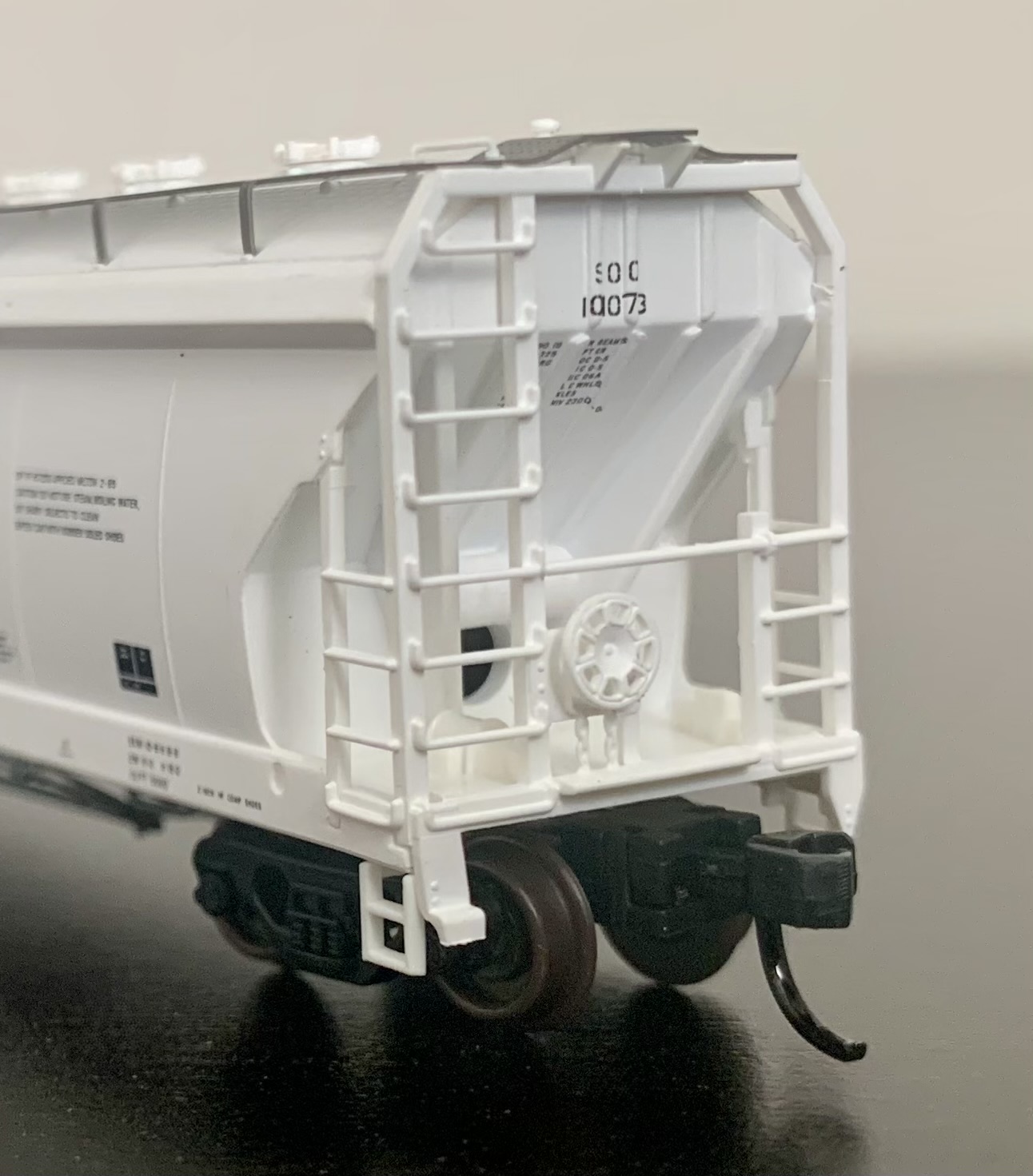
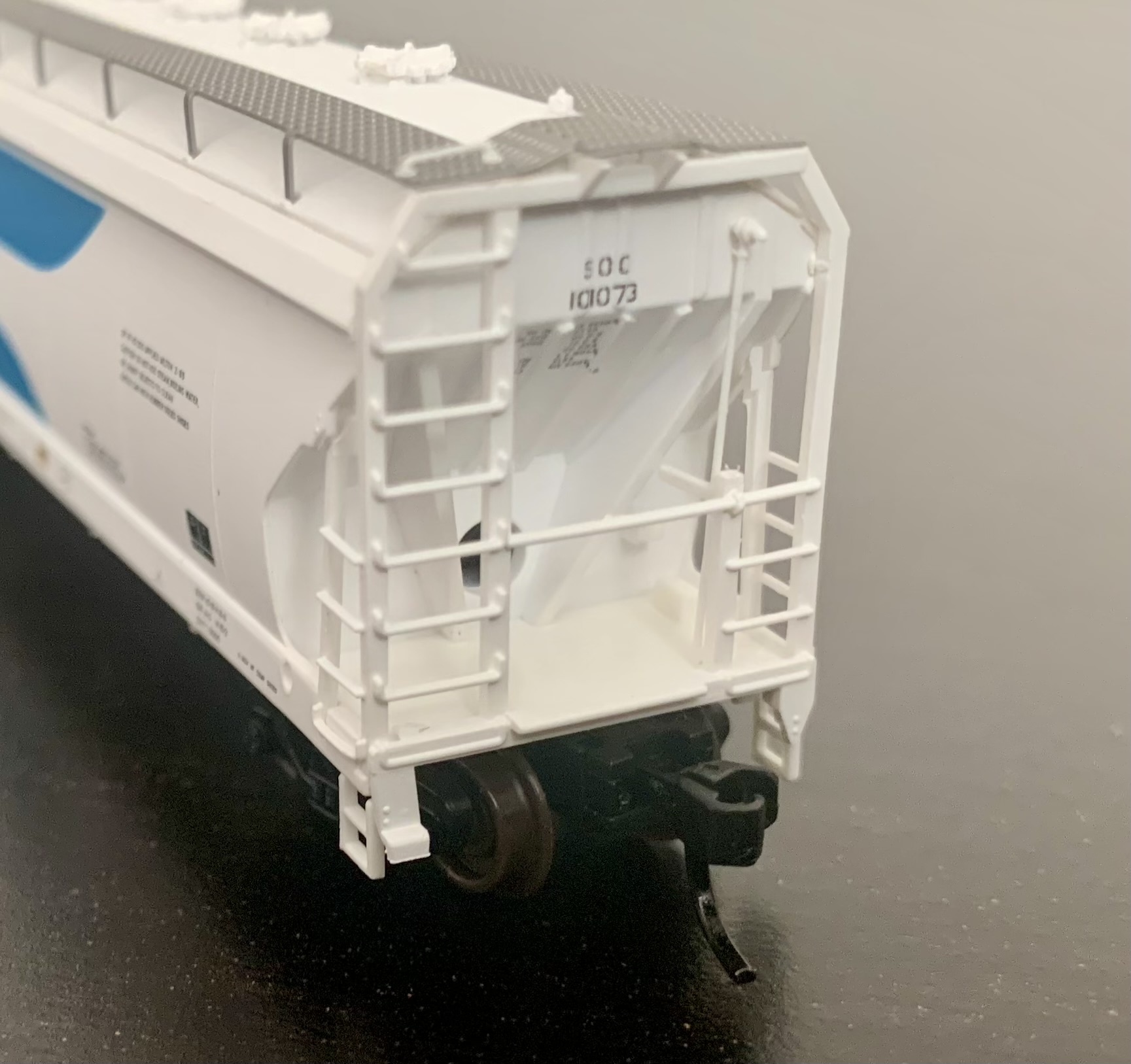
The top of the covered hopper features eight 20” round loading hatches with six fastening levers, two pressure release valves, and a finely detailed etched metal Apex Tri-Lok see-thru roofwalk with laterals and two separately applied grab irons. The open design roofwalk allows the quick shedding of water, snow, and ice. The vacuum relief valves protect the hopper from deformation when exterior atmospheric pressure fluctuates. Finally, nice attention to detail is the off centering of the two end top loading hatches from the other six hatches that are evenly spaced. The prototype hopper car has a wider space between the “first” and “second” hatch on both ends.

The underside features an elaborate plastic four pneumatic outlet piping configuration with prototype correct valves and connections. The hopper gates are properly identified on the lower sill with the four-hopper alpha sequence B/BC/AC/A. The covered hopper rides along 100-ton roller bearing trucks and brown plastic wheels. Finally, the model is equipped with proper height truck-mounted AccuMate® couplers.

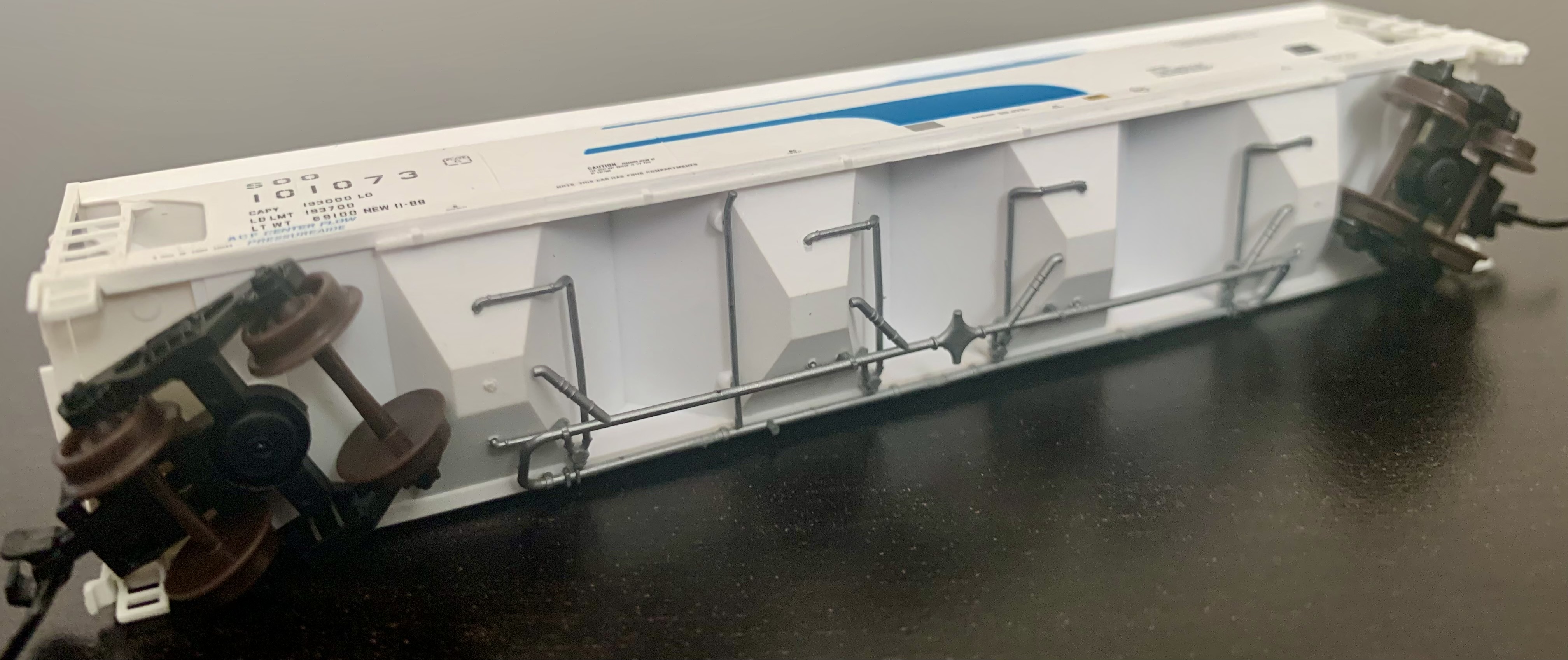
The hopper measured 4 3/16 inches in length and weighed 1.1 ounces, which is a perfect weight according to the National Model Railroad Association (NMRA) recommendations for a model of this size. I found it an excellent runner while testing the car on Kato Unitrack with no operating issues around curves or through turnouts at slow and medium speeds. Minimum recommended operating radius is 11 inches.
Conclusions
I have no pressure giving high marks to the Atlas ACF PressureAide Covered Hopper. Quality built model with exceptional attention to detail – wonderful underside piping structure with the most meticulous parts featured…in N Scale!!! Great addition of safety valves, blow down rod, and etched metal roofwalk. Sharp printing and bright color. My only gripe are those awful brown plastic wheels. They will be replaced – I wish model companies would stop installing them…not a realistic or very attractive look. But do not get stuck on that small detail – just go with the flow and grab a few of the Atlas PressureAide Hoppers for your modern era layout.To View the Entire Collection of Atlas PressureAide Hoppers Cars: CLICK HERE

